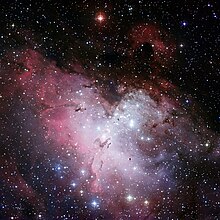Post-main-sequence
evolution of low mass stars
Understanding the post-main-sequence
evolution of low mass stars is imperative when it comes to understanding the
entire process of the birth and death of a star. In this blog post, we will
exclusively focus on the post-main-sequence evolution of low mass stars.
However, before delving into the subject, it is important to go over a life
cycle of a low mass star first. As shown in below image, the low mass stars go
through different phases than the high mass stars. Even though the image shows
the same number of steps of stellar evolution for both high and low mass stars,
their processes are essentially different in detail.
As you can see from above
image, low mass stars have following life cycle steps:[1]
1.
Protostar: A star system forms when a cloud of interstellar gas collapses under
gravity. Typical giant molecular clouds are roughly estimated to be 100
light-years across, and they contain up to 6,000,000 solar masses! When the
giant molecular clouds collapse, it breaks into small fragments. In each of
these, the collapsing gas emits gravitational potential energy as heat energy.
Through this process, the temperature and pressure are destined to increase,
and a garment goes through a condensing phase and becomes a rotating sphere of
extremely hot gas called protostar.[2]
2.
Yellow main-sequence star: In the core of a low-mass star, four hydrogen nuclei
fuse into a single helium nucleus by the series of reactions known as the
proton-proton chain.
3.
Red giant star: The post-main-sequence
evolution stage starts from this third stage where the core hydrogen is
exhausted, and the core shrinks and heats. Hydrogen fusion starts around the
inert helium core, which causes the star to become a red giant.[3]
Once the star used up the core hydrogen, the gravitational core collapses and
it causes the core to be heated. It is also worth to know that low mass stars go
through the entire life cycle slower than high-mass stars, including
post-main-sequence steps.
4.
Helium core-fusion star: After this
stage, Helium fusion starts in the core when it heats enough to fuse Helium
into Carbon. This triggers the core to expand and cause the speed of hydrogen
fusion rate to decrease. This allows the star’s outer layers to shrink and the
size of the star decreases as well.
6.
Planetary nebula: The sixth step is
called Planetary nebula that the low-mass star becomes a dying star that expels
the surface layers in a planetary nebula with the exposed inert core left
behind.
7.
White Dwarf: The star eventually becomes
a white dwarf, which is made mostly of carbon and oxygen. This is due to the
low heat in the core of the low-mass star that never gets hot enough to make
heavier elements.
Of course, the process of
the stellar evolution cannot be studied based on observing the life of a single
star since the process occurs too slowly to be detected within the span of our
civilization. Thus, astrophysicists use computer models to simulate the process
of this stellar evolution, including the post-main-sequence evolution, to
understand the universe. Even though it takes much effort to understand the
stellar evolution, it is still an interesting subject of study since we are
star-species as Carl Sagan once said, and our sun will eventually face the same fate as just any other stars in the far future. However, we wouldn’t exist on Earth then!
[1] Bennett, Jeffrey O. The Essential
Cosmic Perspective, Boston: Addison-Wesley, 2012, pg. 354-355
[2]
Prialnik, Dina(2000) An Introduction to the Theory of Stellar Structure and
Evolution, Cambridge University Press, ISBN 0-421-65065-8
[3] http://www.ucolick.org/~woosley/ay112-14/lectures/lecture14.4x.pdf














